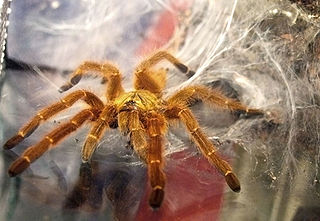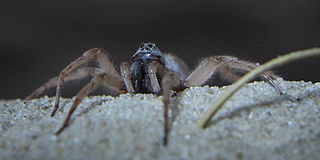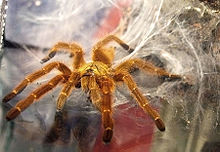
Ground spiders comprise Gnaphosidae, the seventh largest spider family with over 2,000 described species in over 100 genera distributed worldwide. There are 105 species known to central Europe, and common genera include Gnaphosa, Drassodes, Micaria, Cesonia, Zelotes and many others. They are closely related to Clubionidae. At present, no ground spiders are known to be seriously venomous to humans.

The Harpactirinae are a subfamily of tarantulas which are native to the continent of Africa. Like many Old World tarantulas, they have a relatively strong venom and can inflict a painful bite.

Pterinochilus murinus or the orange baboon tarantula, is a nocturnal spider in the family Theraphosidae that was first described in 1897 by Reginald Innes Pocock. This species is found in Angola, as well as central and southern Africa. It is a member of the subfamily Harpactirinae, baboon spiders.

Ceratogyrus is a genus of tarantulas found in southern Africa. They are commonly called horned baboons for the foveal horn found on the peltidium in some species.

Pachygnatha is a genus of long-jawed orb-weavers that was first described by Carl Jakob Sundevall in 1823.

Allocosa is a spider genus of the wolf spider family, Lycosidae. The 130 or more recognized species are spread worldwide.

Olios is the largest genus of huntsman spiders, containing 166 species. They are found throughout the world, with most species occurring in hot countries. The genus was first described by Charles Athanase Walckenaer in 1837.

Zeria is a genus of solpugid camel spiders, first described by Eugène Simon in 1879.

Oxyopes is a genus of lynx spiders found worldwide. It includes arounds 300 species and is classified under the lynx spider family Oxyopidae. Like other lynx spiders, they are easily recognizable by the six larger eyes arranged hexagonally on top of the head (prosoma), with the remaining smaller two eyes in front. They are also characterized by long spine-like bristles (setae) on their legs. They are ambush predators, actively hunting prey by sight. Though they produce and use silk, they do not build webs to capture prey.

Ctenus is a genus of wandering spiders first described by Charles Athanase Walckenaer in 1805. It is widely distributed, from South America through Africa to East Asia. Little is known about the toxic potential of the genus Ctenus; however, Ctenus medius has been shown to share some toxic properties with Phoneutria nigriventer, such as proteolytic, hyaluronidase and phospholipase activities, in addition to producing hyperalgesia and edema. The venom of C. medius also interferes with the complement system in concentrations in which the venom of P. nigriventer is inactive, indicating that some species in the genus may have a medically significant venom. The venom of C. medius interferes with the complement component 3 (C3) of the complement system; it affects the central factor of the cascades of the complement, and interferes with the lytic activity of this system, which causes stronger activation and consumption of the complement components. Unlike C. medius, the venom of P. nigriventer does not interfere with lytic activity.

Scotophaeus is a genus of ground spiders that was first described by Eugène Simon in 1893.
Augacephalus is a genus of harpacterine theraphosid spiders. It has three species, all of which are found in Africa.
Diores is a genus of spiders in the family Zodariidae.











